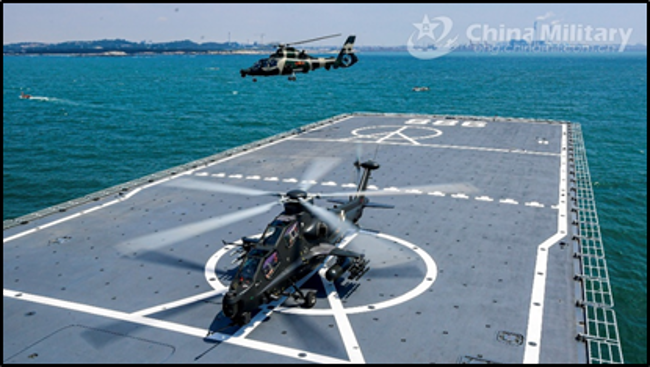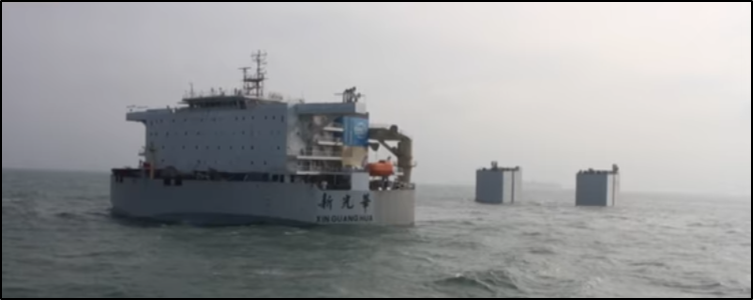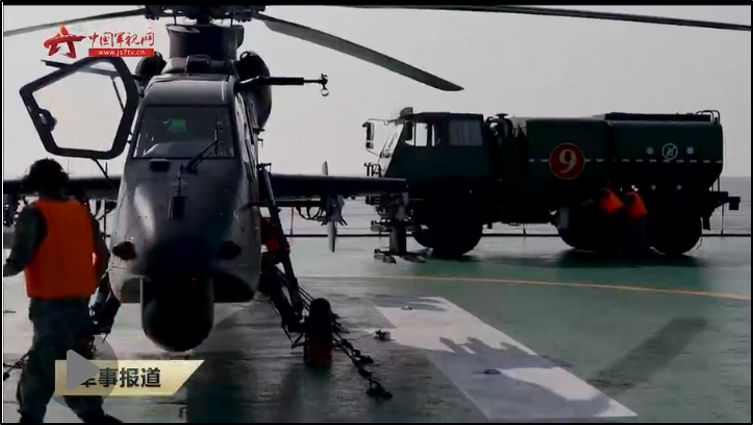By: John Dotson
Introduction
In August, naval and aviation forces of the People’s Republic of China (PRC) conducted exercise activity in four different maritime regions: the Bohai Gulf, Yellow Sea, East China Sea, and South China Sea. This unusual level of exercise activity represented an effort to demonstrate the People’s Liberation Army (PLA)’s increasing maritime capabilities (SCMP, August 24), as well as a symbolic political statement “aimed at deterring Taiwan secessionists” (Global Times, August 23). These exercises may also have been intended in part as a message to the United States and its military allies, who kicked off the biennial Rim of the Pacific (RIMPAC) exercise on August 17 without Chinese participation (U.S. Pacific Fleet, August 17; USNI, August 24).
One of the noteworthy highlights of PLA exercise activity in August was a series of PLA Ground Force (PLAGF) helicopter landing and troop deployment drills at sea. These drills reportedly involved airframes and personnel from the 71st and 73rd Group Armies, as well as both PLA Navy and civilian vessels. Of particular note was the reported use of a civilian semi-submersible heavy lift vessel in some of these drills. This represents another example of the PLA’s drive to achieve “military-civil fusion”—as well as an innovative use of civilian shipping, which could potentially increase the PLA’s capabilities to conduct joint maritime operations in either a Taiwan invasion scenario or an island landing campaign. Image: A Z-9 multi-mission helicopter (background) and a WZ-10 attack helicopter (foreground), part of an unidentified aviation brigade subordinate to the PLA 73rd Group Army, conduct landing drills on the flight deck of the PLA Navy amphibious transport dock Yimengshan. The training was held in “an undisclosed sea area” on August 3. (Image source: PRC Ministry of Defense, August 12)
Image: A Z-9 multi-mission helicopter (background) and a WZ-10 attack helicopter (foreground), part of an unidentified aviation brigade subordinate to the PLA 73rd Group Army, conduct landing drills on the flight deck of the PLA Navy amphibious transport dock Yimengshan. The training was held in “an undisclosed sea area” on August 3. (Image source: PRC Ministry of Defense, August 12)
 Image: A Z-9 multi-mission helicopter (background) and a WZ-10 attack helicopter (foreground), part of an unidentified aviation brigade subordinate to the PLA 73rd Group Army, conduct landing drills on the flight deck of the PLA Navy amphibious transport dock Yimengshan. The training was held in “an undisclosed sea area” on August 3. (Image source: PRC Ministry of Defense, August 12)
Image: A Z-9 multi-mission helicopter (background) and a WZ-10 attack helicopter (foreground), part of an unidentified aviation brigade subordinate to the PLA 73rd Group Army, conduct landing drills on the flight deck of the PLA Navy amphibious transport dock Yimengshan. The training was held in “an undisclosed sea area” on August 3. (Image source: PRC Ministry of Defense, August 12)
PLA Ground Force Helicopter Maritime Landing Drills in August 2020
Helicopter Drills Involving the 73rd Group Army and the PLA Navy
PRC state media sources have reported that, on August 3, elements of the PLA Ground Force 73rd Group Army conducted joint training drills with at least one PLA Navy vessel, identified as the amphibious transport dock Yimengshan (沂蒙山) (LPD-988). These sources identified the location only as “an undisclosed sea area,” although the training was conducted within sight of land (see images below). The training appeared to involve shipborne landing and take-off familiarization training for pilots, as well as the deployment of soldiers to and from transport helicopters (PRC Ministry of Defense, August 12). It is unclear whether this represented smaller-scale, individual unit training, or whether it was conducted as part of a broader and more complex exercise scenario.
Whichever the case, the drills indicate intent to pursue closer joint coordination between the army and the navy—and specific interest in exploring the use of naval vessels as staging platforms for PLA Ground Force soldiers and aviation assets. This is not entirely new: in recent years the PLAGF has sought to increase the proficiencies of its aviation assets for operating over water, and PLAGF helicopters have conducted landing and troop deployment drills on PLA vessels since at least 2017 (China Military Online, August 22, 2017). The August 3 drills demonstrate the PLA’s continuing interest in the potential employment of naval platforms as afloat way stations to support land-based rotary-wing aviation.
Helicopter Drills Involving the 71st Group Army and a Civilian Cargo Vessel
Another set of maritime drills was conducted by PLA Ground Force aviation units in the latter half of August, which was even more noteworthy in terms of the PRC’s potential future maritime capabilities. Per state media, the landing drills (conducted on or about August 19) involved helicopters from an unidentified aviation brigade subordinate to the PLA Ground Force 71st Group Army, and took place aboard a civilian semi-submersible heavy lift vessel (大型半潜船, daxing banqian chuan), or SSHLV, which was underway in the Yellow Sea. [1] In this training scenario, after first flying to a “target island” (目标岛屿, mubiao daoyu), the helicopters landed on the ship for “rush repairs” (抢修, qiangxiu), refueling, weapons reloading, and the transfer of wounded personnel (Huanqiu Shibao, August 21; China Military Online, August 21).
The numbers of aircraft and personnel involved are unclear, but available text and photo sources appear to indicate the involvement of Z-8 transport and Z-19 attack helicopters (Kuaibao.qq.com, August 20). Media coverage of the event also indicated the presence of PLA personnel embarked on the ship in support of the training evolutions, to include a command element (see accompanying photos).
Semi-Submersible Vessels and “Military-Civil Fusion”
SSHLVs are generally constructed with superstructures fore and aft, and a lower deck amidships. Such vessels have the capability to adjust their freeboard with the use of ballast tanks, to the extent that the central deck could become submerged. This is a measure conducive to the loading of large structures and other types of heavy cargo—either pierside, or at sea with the use of tugs (Royal Boskalis Westminster N.V., June 14, 2018). China’s robust shipbuilding industry is a leader in SSHLV production, and 27 of the 34 large semi-submersible vessels built within the last 25 years are operated by Chinese companies. [2] In 2016 a shipyard in Guangdong Province completed construction of the Xinguanghua, reportedly the world’s second-largest such vessel (CGTN/Youtube, December 9, 2016). Image: The Xinguanghua (新光华 / 新光華), reportedly the world’s second-largest SSHLV, operating semi-submerged while underway (undated, likely 2016). (Image source: CGTN/Youtube, December 9, 2016)
Image: The Xinguanghua (新光华 / 新光華), reportedly the world’s second-largest SSHLV, operating semi-submerged while underway (undated, likely 2016). (Image source: CGTN/Youtube, December 9, 2016)
 Image: The Xinguanghua (新光华 / 新光華), reportedly the world’s second-largest SSHLV, operating semi-submerged while underway (undated, likely 2016). (Image source: CGTN/Youtube, December 9, 2016)
Image: The Xinguanghua (新光华 / 新光華), reportedly the world’s second-largest SSHLV, operating semi-submerged while underway (undated, likely 2016). (Image source: CGTN/Youtube, December 9, 2016)
Discussion of the use of SSHLVs to support PLA operations dates back to at least 2017, when construction was completed on the Zhen Hua-33 (振华-33) in the city of Qidong (Jiangsu Province). The ship was touted in PRC press as “China’s first 50,000-ton military-civilian dual-use semi-submersible vessel,” capable of providing “berthing transition [for] a big ship over 10,000 tons, maritime military relay support for ship-borne helicopters, [and] rush-repair and evacuation of damaged warships” (China Military Online, March 15, 2017).
The idea of using civilian vessels such as SSHLVs to support military operations provides a further illustration of the PRC’s ongoing drive to pursue “military-civil fusion” (军民融合, jun-min ronghe), or MCF. MCF is a major ongoing policy initiative that seeks to share resources across civilian industry and the PLA, in an effort to boost both China’s military capabilities and its economic development (China Brief, October 8, 2019; U.S. State Department, May 28). This has included a push to expand and professionalize the PLA reserve and militia units that are either housed within state-owned enterprises, or which otherwise seek to leverage the technical skills of personnel in commercial entities (China Brief, October 8, 2019; China Brief, October 8, 2019).
Media coverage of the August helicopter drills included mention of the need for work and coordination among various “maritime relay platform organizations” (海上中继平台组织, haishang zhongmi pingtai zuzhi); as well as the need for “maintenance and repair personnel platform combined support” (机务修理人员平台综合保障, jiwu xiuli renyuan pingtai zonghe baozhang) (Huanqiu Shibao, August 21). Although it is speculative, such vague references presumably refer to both PLA detachments and civilian shipboard work units—and possibly to the mobilization of civilian sailors into PLA maritime militia units, as well. The extent to which PLA detachments might be deployed to civilian vessels, and to which civilian personnel could be mobilized for shipboard military support operations, is an area worthy of further study.
The Potential Role of SSHLVs in Maritime Operations
PRC media commentary on the August drills, both official and unofficial, expressed enthusiasm for the potential use of SSHLVs to support the PLA in future maritime operations. Colonel Xu Yifeng (徐益锋), deputy commander of the 71st Group Army aviation brigade engaged in the training, was cited as stating that the drills had “improved the pilots’ deck-landing ability on the offshore platforms and also the maintenance personnel’s comprehensive support capacity, laying a solid foundation for the cross-sea operations of the PLA Army’s helicopters” (China Military Online, August 21). Another source noted that the SSHLV’s large deck space and cargo carrying capacity made it “extremely well-suited to supplement amphibious landing ships,” and that it might even “serve as a temporary helicopter carrier” (作为临时直升机母舰, zuowei linshi zhishengji mujian) (Kuaibao.qq.com, August 20).
Particularly noteworthy was the idea that such a vessel could act as a “maritime relay platform” (海上中继平台, haishang zhongji pingtai) to support PLA operations. As indicated in one state newspaper, “When conducting major missions on the periphery of islands and reefs, [one side] could deploy a large-scale semi-submersible ship… to act as a maritime relay platform; in addition to increasing the ocean-crossing combat capabilities of helicopter units, it would also increase helicopter combat radius” (Huanqiu Shibao, August 21). Another online commentary indicated that:
Although our country does not have dedicated military-use [SSHLVs], as we move down the military-civilian dual-use road, in wartime this kind of [SSHLV] has functions that must not be overlooked. First, [SSHLVs] can reliably transport tremendous loads of equipment across long distances, raising up our country’s strategic transport capabilities. Next, [SSHLVs] can act as seaborne bases, strengthening our military’s amphibious attack capabilities. Finally, this kind of ship can become a maritime repair and supply platform, providing wartime equipment logistical support. (Kuaibao.qq.com, August 20) Image: PLA personnel conducting helicopter refueling and weapons reloading drills on the deck of a civilian SSHLV, August 2020. (Image source: Junshi Baodao, August 19)
Image: PLA personnel conducting helicopter refueling and weapons reloading drills on the deck of a civilian SSHLV, August 2020. (Image source: Junshi Baodao, August 19) Image: Colonel Xu Yifeng, identified as the “deputy commander of a certain 71st Group Army aviation brigade,” speaks with a PRC state media reporter about the helicopter training drills. (Image source: Junshi Baodao, August 19)
Image: Colonel Xu Yifeng, identified as the “deputy commander of a certain 71st Group Army aviation brigade,” speaks with a PRC state media reporter about the helicopter training drills. (Image source: Junshi Baodao, August 19)
 Image: PLA personnel conducting helicopter refueling and weapons reloading drills on the deck of a civilian SSHLV, August 2020. (Image source: Junshi Baodao, August 19)
Image: PLA personnel conducting helicopter refueling and weapons reloading drills on the deck of a civilian SSHLV, August 2020. (Image source: Junshi Baodao, August 19) Image: Colonel Xu Yifeng, identified as the “deputy commander of a certain 71st Group Army aviation brigade,” speaks with a PRC state media reporter about the helicopter training drills. (Image source: Junshi Baodao, August 19)
Image: Colonel Xu Yifeng, identified as the “deputy commander of a certain 71st Group Army aviation brigade,” speaks with a PRC state media reporter about the helicopter training drills. (Image source: Junshi Baodao, August 19)
Conclusion
The idea of using SSHLVs to support naval operations is not new: for example, in an initiative dating back to at least 2014, the U.S. Navy has explored this idea as part of the “Mobile Landing Platform” concept. This envisions the employment of SSHLVs, in lieu of traditional (and more expensive) naval amphibious vessels, to support mission areas such as counter-terrorism and humanitarian relief by serving as mothership platforms for landing craft air cushion (LCAC) amphibious hovercraft (U.S. Navy/Youtube, March 6, 2014). However, the PLA’s experimentation with using SSHLVs as a potential “maritime relay platform”—intended to extend the combat radius of PLA rotary-wing aircraft, as well as to provide a mobile way station for logistical and medical support—is an innovative concept.
In addition to the roles and logistical skill sets reportedly practiced (at least at a basic level) in August, this also raises the potential prospect of SSHLVs being deployed as makeshift helicopter carriers. Such a move would increase the number of platforms available to provide the PLA with maritime air support in either a Taiwan Strait conflict, or a smaller-scale island seizure campaign. The extent to which these aspirational concepts might be fleshed out through further training and organizational development will be a topic well worth watching.
The author is grateful to Lt. Col. Dennis Blasko (U.S. Army, retired) for his suggestions and comments on an initial draft of this article. Any errors are solely my own responsibility.
No comments:
Post a Comment